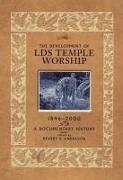- Start
- The Development of LDS Temple Worship, 1846-2000: A Documentary History
The Development of LDS Temple Worship, 1846-2000: A Documentary History
Angebote / Angebote:
from the jacket flap: Originally, in the Nauvoo temple and Utah's Endowment House, people dressed for the temple in a long white nightshirt or nightgown that extended below the knee. At a veil representing heaven, the participant's underclothing was marked, this being the crowning act of the ceremony. There was a logic to this sequence in that one promised to live a moral life and then received the marks to remind him or her of the promises made, versus the sequence today whereby an initiate puts on pre-marked underclothes at the beginning of the endowment ceremony in a washing room.In a related departure, the nightshirt used to be marked along with the underwear as a nod to modesty. Brigham Young gave instructions on this in 1869 when he "took the scissors & soon made the marks, " saying that even if the "shirt was colored[, ] mark it--[I]f [there is] flannel or buckskin between [the] shirt & garment[, ] that also should be marked."Twenty-five years later, a new First Presidency decided that whereas "it has been the practice to mark the shirt, ... we think this unnecessary as it is not strictly a part of the Temple clothing. The marking of the garment should be done in the washing room and not at the veil, and the greatest care should be taken to see that no person is permitted to leave that room wearing an unmarked garment."It is the mind of the First Presidency, " Church leaders later wrote to the St. George temple president, "that you adopt as soon as it can be done conveniently the practice of brethren wearing white pants while doing Temple work. This change would necessarily do away with the long white shirt usually worn by them, and admit of their wearing the regular white shirt, with collar and white tie if they choose to do so."In time, the garment was standardized as a one-piece "union suit, " although this was not the original design. "The garment is [now] like the ordinary union suit, " Apostle John A. Widtsoe said in 1934, and "much better than the two-piece suits our grandfathers and grandmothers grew up with." When two-piece garments were later re-introduced, the change was met with some resistance, similar to the reaction in 1923 when the garments were shortened to two inches above the ankles and wrists.By 1937, one could purchase unmarked undergarments at ZCMI, and in the temple they were tailored, more or less, according to guidelines issued by Elder George F. Richards that year: "When marking the garments, place the garment on the person unmarked, place pins in the marked space, take the garments off[, ] and proceed to cut the marks." Some aspects of the ceremony have been altered, the foregoing being only one example of many such refinements. It is instructive to know what has changed and what has not and why, as well as what the process has been. These are issues that are both interesting theologically and of significance on a personal level for those who have been to the temple.
Folgt in ca. 15 Arbeitstagen
